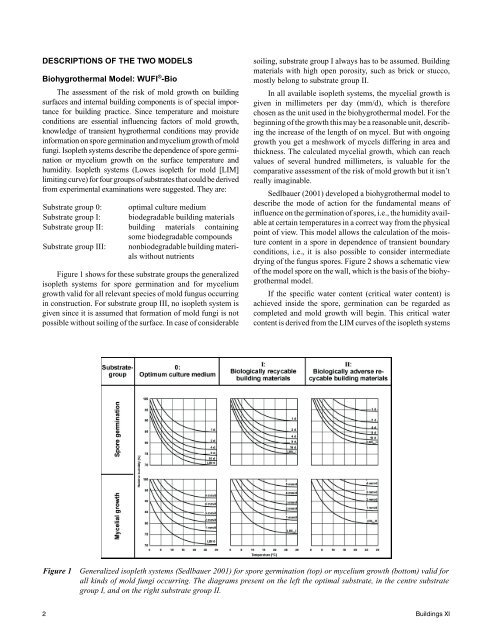Comparative Evaluation of the Predictions of Two Established Mold ...
Comparative Evaluation of the Predictions of Two Established Mold ...
Comparative Evaluation of the Predictions of Two Established Mold ...
You also want an ePaper? Increase the reach of your titles
YUMPU automatically turns print PDFs into web optimized ePapers that Google loves.
DESCRIPTIONS OF THE TWO MODELS<br />
Biohygro<strong>the</strong>rmal Model: WUFI ® -Bio<br />
The assessment <strong>of</strong> <strong>the</strong> risk <strong>of</strong> mold growth on building<br />
surfaces and internal building components is <strong>of</strong> special importance<br />
for building practice. Since temperature and moisture<br />
conditions are essential influencing factors <strong>of</strong> mold growth,<br />
knowledge <strong>of</strong> transient hygro<strong>the</strong>rmal conditions may provide<br />
information on spore germination and mycelium growth <strong>of</strong> mold<br />
fungi. Isopleth systems describe <strong>the</strong> dependence <strong>of</strong> spore germination<br />
or mycelium growth on <strong>the</strong> surface temperature and<br />
humidity. Isopleth systems (Lowes isopleth for mold [LIM]<br />
limiting curve) for four groups <strong>of</strong> substrates that could be derived<br />
from experimental examinations were suggested. They are:<br />
Substrate group 0: optimal culture medium<br />
Substrate group I: biodegradable building materials<br />
Substrate group II: building materials containing<br />
some biodegradable compounds<br />
Substrate group III: nonbiodegradable building materials<br />
without nutrients<br />
Figure 1 shows for <strong>the</strong>se substrate groups <strong>the</strong> generalized<br />
isopleth systems for spore germination and for mycelium<br />
growth valid for all relevant species <strong>of</strong> mold fungus occurring<br />
in construction. For substrate group III, no isopleth system is<br />
given since it is assumed that formation <strong>of</strong> mold fungi is not<br />
possible without soiling <strong>of</strong> <strong>the</strong> surface. In case <strong>of</strong> considerable<br />
soiling, substrate group I always has to be assumed. Building<br />
materials with high open porosity, such as brick or stucco,<br />
mostly belong to substrate group II.<br />
In all available isopleth systems, <strong>the</strong> mycelial growth is<br />
given in millimeters per day (mm/d), which is <strong>the</strong>refore<br />
chosen as <strong>the</strong> unit used in <strong>the</strong> biohygro<strong>the</strong>rmal model. For <strong>the</strong><br />
beginning <strong>of</strong> <strong>the</strong> growth this may be a reasonable unit, describing<br />
<strong>the</strong> increase <strong>of</strong> <strong>the</strong> length <strong>of</strong> on mycel. But with ongoing<br />
growth you get a meshwork <strong>of</strong> mycels differing in area and<br />
thickness. The calculated mycelial growth, which can reach<br />
values <strong>of</strong> several hundred millimeters, is valuable for <strong>the</strong><br />
comparative assessment <strong>of</strong> <strong>the</strong> risk <strong>of</strong> mold growth but it isn’t<br />
really imaginable.<br />
Sedlbauer (2001) developed a biohygro<strong>the</strong>rmal model to<br />
describe <strong>the</strong> mode <strong>of</strong> action for <strong>the</strong> fundamental means <strong>of</strong><br />
influence on <strong>the</strong> germination <strong>of</strong> spores, i.e., <strong>the</strong> humidity available<br />
at certain temperatures in a correct way from <strong>the</strong> physical<br />
point <strong>of</strong> view. This model allows <strong>the</strong> calculation <strong>of</strong> <strong>the</strong> moisture<br />
content in a spore in dependence <strong>of</strong> transient boundary<br />
conditions, i.e., it is also possible to consider intermediate<br />
drying <strong>of</strong> <strong>the</strong> fungus spores. Figure 2 shows a schematic view<br />
<strong>of</strong> <strong>the</strong> model spore on <strong>the</strong> wall, which is <strong>the</strong> basis <strong>of</strong> <strong>the</strong> biohygro<strong>the</strong>rmal<br />
model.<br />
If <strong>the</strong> specific water content (critical water content) is<br />
achieved inside <strong>the</strong> spore, germination can be regarded as<br />
completed and mold growth will begin. This critical water<br />
content is derived from <strong>the</strong> LIM curves <strong>of</strong> <strong>the</strong> isopleth systems<br />
Figure 1<br />
Generalized isopleth systems (Sedlbauer 2001) for spore germination (top) or mycelium growth (bottom) valid for<br />
all kinds <strong>of</strong> mold fungi occurring. The diagrams present on <strong>the</strong> left <strong>the</strong> optimal substrate, in <strong>the</strong> centre substrate<br />
group I, and on <strong>the</strong> right substrate group II.<br />
2 Buildings XI

















